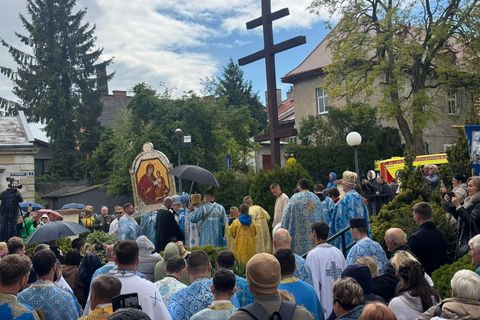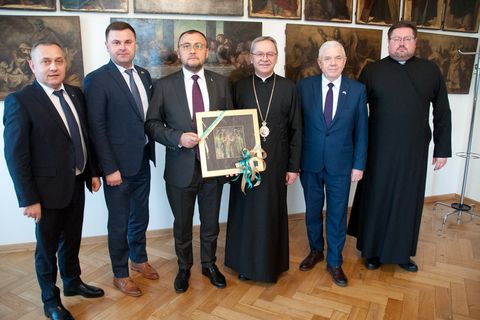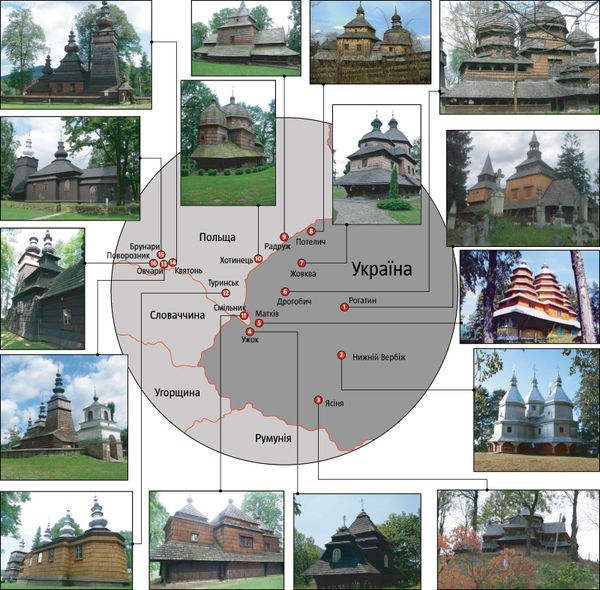Archeparchy of Przemyśl-Warsaw
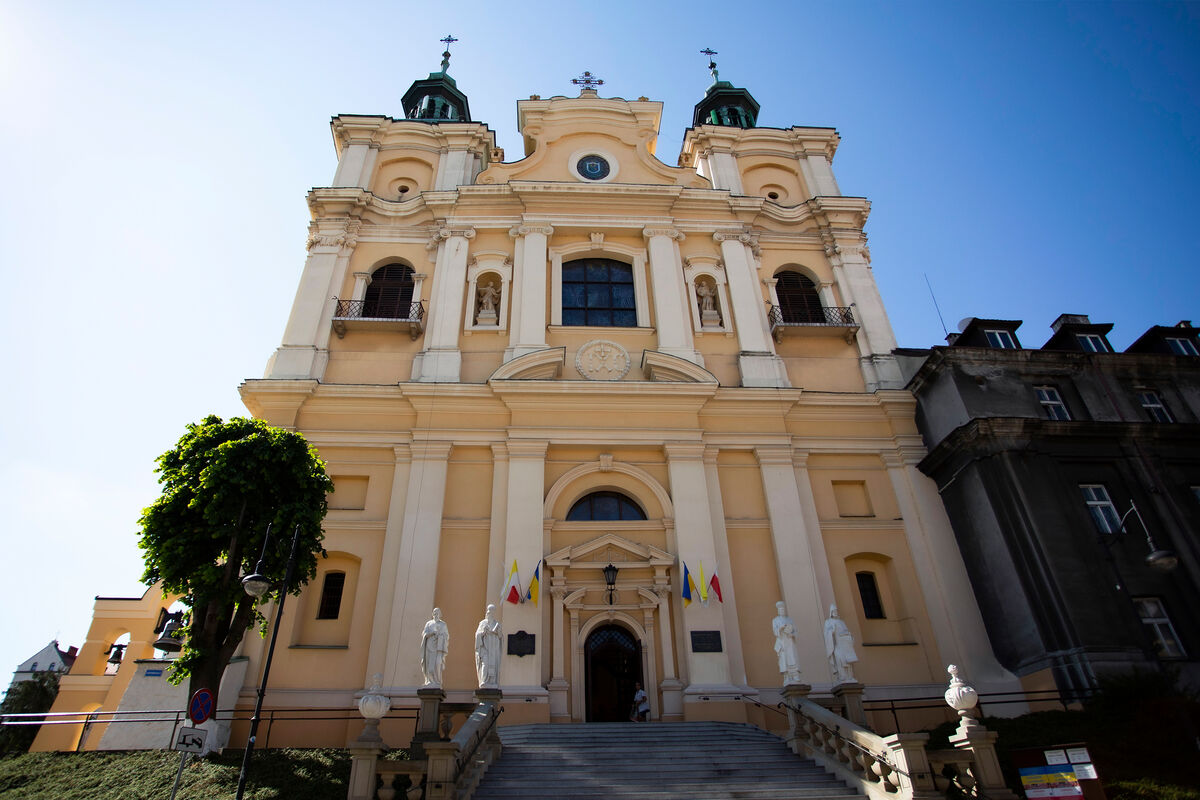
About
The Archeparchy of Przemysl-Warsaw UGCC is a structural part of the Ukrainian Greek Catholic Church with two centers in Poland. The first center is located in Przemysl and the second one is in Warsaw. The Archeparchy embraces eastern territories of Poland where Warmian-Masurian, Podlaskie, Lublin, Podkarpacki, Lesser Poland Voivodeships and parts of Mazovian, Kuyavian-Pomeranian and Pomeranian Voivodeships are located. Thus, the total area of the Archeparchy is around 132 644 km2.
The modern Archeparchy of Przemysl-Warsaw consists of 7 deaneries:
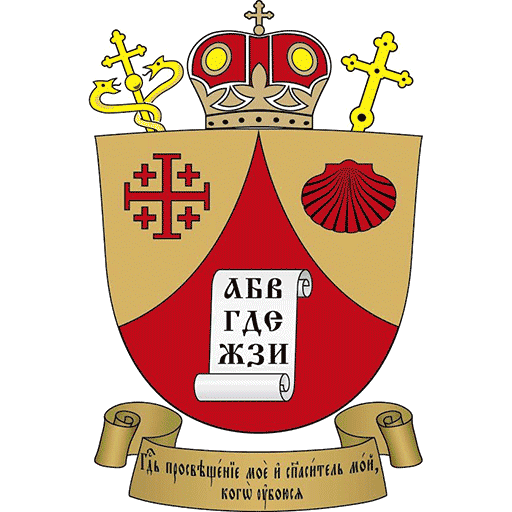
- Elblag (12 parishes)
- Cracow-Krynica (14 parishes)
- Olsztyn (9 parishes)
- Przemysl (14 parishes)
- Sanok (14 parishes)
- Wegorzewo (10 parishes)
- Warsaw-Lublin (6 parishes)
According to the statistical data from 2017, the Archeparchy of Przemysl-Warsaw numbers 30 thousand faithful who are united around 72 parishes where 47 priests (36 eparchial priests, 11 hieromonks, 4 deacons) perform their ministry. Beside this, there are monastic congregations (with 14 monks and 77 nuns) on the territory of the archeparchy.
It is important to mention that the Archeparchy of Przemysl — Warsaw has its Archeparchial Seminary in Lublin. Also, there are active Charity organizations Caritas at the archeparchy administration, the archeparchial Blahovist magazine, and the newspaper Christian Voice which are published every month. There is also the publishing house of the Archeparchy of Przemysl-Warsawa. As for educational institutions, the archeparchial school for cantors works actively.
Location
Materials
Bishops
Since the 7th of November, 2015 His Eminence Archbishop Yevgen Popovych has been the ruling Archbishop of the Archeparchy of Przemysl-Warsaw.
The Metropolitan Cathedral of the Archeparchy of Przemysl-Warsaw is St. John the Baptist Cathedral in Przemysl. Also, in the Archeparchy there is a Church and Monastery of the Dormition of the Mother of God in Warsaw.
History
There is little information about the eparchy of Przemysl in the first years of its existence. Historians argue over the period when it was established, opinions vary from the 10th to 12th century. However, the eparchy probably existed in the second half of the 11th century (as mentioned in Nestor’s Chronicle).
The first bishop, ordained by the Metropolitan of Kyiv in 1218, was Antoni Dobryna.
In 1422 the eparchy of Przemysl joined with the eparchy in Sambor, forming the eparchy of Przemysl-Sambor. The capital of the eparchy was Przemysl.
In the 17th century, Przemysl bishops began using the title: Bishop of Przemysl, Sambor, and Sanok. There has never been the eparchy of Sanok but during Bp. Antoni Winnicki’s office built the second bishop's residence there.
In 1691, Bishop Innocenty Winnicki accepted the Union with Rome and gained complete power in the eparchy of Przemysl.
After the first partitioning of Poland, the Greek Catholic Church was forced to implement Church reforms of Empress Maria Theresa and Joseph II. They introduced some organizational, legal, and administrative changes in the eparchy as well as altered its borders.
In the Second Republic of Poland period, the greek catholic eparchy of Przemysl was part of the Metropolis of Lviv — Halych. According to 1934 schematism, there were 54 deaneries with 759 parishes and 813 lay priests. There were 1359 churches (759 parish churches and 600 filial ones) and 51 monasteries and convents. In the Przemysl Seminary studied 145 students were. In 1934 the number of faithful in the greek catholic eparchy of Przemysl was 1 244 191.
In 1938 the number of faithful in the eparchy was 1 159 380 and before the Second World War, together with the Apostolic Administration of Lemkivschyna, 1 320 000. The eparchy developed many organizations, associations, schools, dormitories, orphanages, and Catholic publishing houses. The Greek Catholic Church owned a lot of property such as buildings, farming fields, gardens, woods, and chattels.
The eparchy, in its collection, possessed plenty of valuable manuscripts, vellum documents, incunables, old prints, and others. They also kept, in the eparchial library or the bishop's residence, art masterpieces like icons, paintings, and other valuable items e.g., the Moldavian cross from the 16th century, stoles given by Bogdan Chmielnicki or the legendary mitre of Przemysl bishops, the so-called King Daniel’s crown. All of these objects were gathered throughout the 1000-year history of the eparchy. Unfortunately, most of them were stolen or lost between 1939 and 1947.
After September 17th, 1939, the bulk of the territory of the eparchy was incorporated into the Soviet Union. In October 1939, the Communist government decided to confiscate demesnes, ban the teaching of religious education at schools, dissolve Catholic organizations and censor Catholic books. They started mass deportations of Greek Catholics. Many Greek Catholic priests were arrested.
The end of the Second World War and new borders changed the eparchy of Przemysl significantly. The Apostolic Administration of Lemkivschyna (140 000 faithful) and the western part of the eparchy, with 23 deaneries, 246 parishes, 420 churches, and 31 chapels, remained within the People’s Republic of Poland. The number of faithful is estimated at 417 006 and the number of priests at 270. In 1944 the Polish government and the Soviet Union signed an agreement to repatriate Ukrainians, Belarussians, Russians, and Ruthenians. Consequently, by the end of 1946, they resettled about 480 000 people to the Soviet Union, 70–80 thousand of whom were Lemkos.
In 1989, the Greek Catholic Church (Byzantine — Ukrainian) received, for the first time since the arrest of Bp. Kocylowski, its bishop. Rev. Mitred Jan Martyniak was ordained as a bishop on 16th October 1989. At first, he was appointed as Primate’ssuffragan and the Vicar General for all Greek Catholics in Poland. On 16th January 1991, the Holy Father John Paul II nominated Bp. Martyniak as the bishop of the eparchy of Przemysl. From that moment, the Greek Catholic Church in Poland started recovery. The bishop had to re-establish offices, institutions, and a network of parishes. The task seemed to be more difficult because in the 90s the Greek Catholics were dispersed around the whole country.
The Holy See wanted to make the pastoral work in the Greek Catholic Church easier and decided to create the Greek Catholic Church province, namely the Metropolis of Przemysl — Warsaw on 31 st May 1996.
Shrines
The Archeparchy of Przemysl — Warsaw is rich in pilgrimage sites. Among them, there is the Marian Sanctuary in Jaroslaw (Poland) which was developed around the miraculous icon of the Mother of God Myloserdia Dweri(The Gate of Mercy). Besides this, a few miraculous icons andrelics are placed in the St John the Baptist Metropolitan Cathedral in Przemysl. They include the miraculous icons of Saint Nicolas, of the Mother of God from Kalwaria Paclawska, and the Blessed Martyrs and Bishops of Przemysl Josafat Kocylowski and Hryhoriy Lakota. Also, there are relics of St Josafat Kuncewicz, Blessed Bp. Josafat Kocylowski, Pratulino Martyrs and a small part of the True Cross. Among the places of worship on the territory of the archeparchy, there is the Nativity of the Theotokos Church in Chotyniec (Podkarpackie Voiodeship, Poland) where a miraculous icon of the Mother of God Hodigitrii is located, and the Nativity of the Theotokos Church in Lublin (Poland). The latter is a place of distinct worship of Blessed Rev. Omelan Kowcz where Korczmin miraculous icon of the Mother of God is displayed. Also, it is worth mentioning a number of Marian Worship places. Among them, there is the Care of the Most Holy Mother of God Chapel on mountain Yavir near Wysowa, Chapel on mountain Zjawlinnia in Kormanice near Przemysl, the Epiphany of the Lord Church in Korczmin (Lublin Voivodeship, Poland), Chapel with a miraculous spring in Radoszyce (Podkarpackie Voiodeship, Poland), Chapel with a miraculous spring in Siedlisk (Lublin Voivodeship, Poland) and more.
Contacts
Address: ul. Błogosławionego bpa Jozafata Kocyłowskiego 4, 37–700 Przemyśl, Polska
Phone/fax: +48 (016) 678-78-68
Email: [email protected]
Website: cerkiew.org
